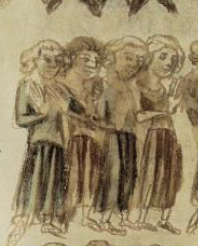
Vaporwave loves to pull from Roman busts and, in recent days, renaissance paintings but what else can we draw inspiration from if not history? A direct result of the Holy Roman Empire being able to obtain law and order is what gave their great artists the ability to paint, sculpt and master the art of architecture.
With governments maintaining safety for their people and marketplaces for trade, no longer did man hunt or fight as a form of survival. Instead, conquest and politics ruled the land, and religion and law formed society.
The Holy Roman Empire could establish such achievements thanks to a little book they called Sachsenspiegel, the Saxon Mirror. Sachsenspiegel, a Middle Low German word, was one of the most important law book of their time — Nothing’s beating the Bible in Rome. It established important rules and regulations concerning property rights, inheritance, marriage and the trading of goods. It set in stone the Feudal law or hierarchy of their cast system. We know them as kings, princes, lords and peasants from medieval fantasy, but here the relationship between man was ordered.
All this and it wasn’t even natively written in Latin.

This isn’t to say this was the only rule of law or even the foundation of every king or leader of the times. It was a record of existing customary law and just like our modern times, it was used when it was necessary for whoever needed to reference it. Still, the Sachsenspiegel held 700 years of significance and is one rarely studied in the west.
The original Die Dresdner Bilderhandschrift des Sachsenspiegels can be found at slub-dresden (The Saxon State and University Library Dresden digital academic catalog) in PDF but the viewing interface is poor. Thankfully, it’s available under the Public Domain Mark 1.0 as a PDF. So naturally, I’ve embedded it below for your viewing pleasure.
If the title above looks foreign to you, the main word I want to point out is Dresdner. As the Sachsenspiegel was so important, thousands of copies were produced in its time but few stood out as significant works of historical art. Named after the location, Dresdner, this version of the Sachsenspiegel is considered the “most artistically valuable.” Inside you’ll find over 924 illustrations and four thousand different portraits on a mere 92 pages.
From the 13th century until as late as 1900, the Sachsenspiegel was part of law and order. With over 700 years of influence, it’s hard to be forgotten. In modern Germany, remnants of the book can be found in “inheritance law and the law of neighborly relations [source].”
Its legacy continued to be cited in pertinent case law as recently as 1932, oddly enough. And it makes one wonder, will the American constitution or any constitution outlive the life the Sachsenspiegel once had.
Looking back it might seem archaic to rely on such a document –especially one that isn’t even written in a modern language (Latin was the main language of the Roman Empire). Yet, the language of our own American constitution can be read, but in an old-fashioned phrasing makes it feel more historic than current.
Yet the same can be said about the medium of music, literature or even visual art, evolution determines the relevance of human invention. Fortunately, we live in a time where evolution means one’s own desire to continue something. Cassettes or MiniDisc have no modern use other than what an indie scene wishes to continue its function. Even the internet has its own archive to ensure data is available for future generations. One could say Vaporwave in itself is the act of never letting nostalgia die. It’s about time someone brought the Sachsenspiegel to German Court again! Who wants to do it to prove a point for me?
Regardless, I found the illustrations ather interesting. Further, the people inside, although nameless, were significant for the time and interesting to imagine their status from their image. Imagine if the Founding Fathers had crudely hired an artist to throw portraits of each other on each page of The Declaration of Independence. It’s interesting how standards have changed.
Which is how I can tie this all together. Vaporwave and really any music genre evolves not only in sound, but in album art. Today we add digital edits via photoshop to create a unique enough design but relatively relatable to the sub-genre we place the music under. Over time, new innovation emerges (Which is why Barber Beats hate is silly) and naturally artists follow suit. What might look great now might evolve to be silly later. Which is what makes art so wonderful. History allows us to determine if something was worth keeping. Nothing is concrete–not even a book of law. Everything changes and, in time, ends. Until then, I’ll be here trying to relate a 13th century book to an underground music scene.
Until the next one, Cheers — KITE0080






